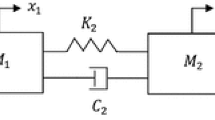Abstract
This paper presents a time-domain technique to generate command inputs for the reduction of residual vibrations in mechanical systems. The technique is based on the generation of motion profiles with zero-crossing points in their frequency spectra at the system resonances in the same way as the zero-vibration (ZV) command generation methods. By including an appropriate negative exponential time function, which contains the system natural frequency and the damping ratio, the resultant input can be applied to damped systems with a result of zero residual vibration. The signals synthesized can be used as a generic physical magnitude in vibratory systems. However, they were particularized for mechanical systems and engineering metrics were used. Compared to other ZV methods, for a short duration input range, the signals obtained have better performance in terms of minimum-acceleration-switch shape which is translated to a smoother motion profile. The development includes the application to single-mode and multiple-mode mechanical systems and the possibility of handling two functional requirements or constraints in the desired application. The analyzed systems are those that can be modeled as discrete linear ones with several vibratory degrees of freedom and can be described with constant parameter motion equations. Experimental results show the efficacy of the method developed with its application to a damped pendulum test platform.
Similar content being viewed by others
References
Singhose, W. E., “Command Shaping for Flexible Systems: A Review of the First 50 Years,” Int. J. Precis. Eng. Manuf., Vol. 10, No. 4, pp. 153–168, 2009.
Singhose, W. E. and Seering, W., “Command Generation for Dynamic Systems,” William Singhose, pp. 131–136, 2011.
Aspinwall, D. M., “Acceleration Profiles for Minimizing Residual Response,” ASME Journal of Dynamic Systems, Measurement, and Control, Vol. 102, No. 3, pp. 3–6, 1980.
Meckl, P. H. and Seering, W. P., “Minimizing Residual Vibration for Point-to-Point Motion,” ASME Journal of Vibration, Acoustics, Stress, and Reliability in Design, Vol. 107, No. 3, pp. 378–382, 1985.
Meckl, P. H. and Seering, W. P., “Experimental Evaluation of Shaped Inputs to Reduce Vibration for a Cartesian Robot,” ASME Journal of Dynamic Systems, Measurement, and Control, Vol. 112, No. 2, pp. 159–165, 1990.
Singer, N. C. and Seering, W. P., “Preshaping Command Inputs to Reduce System Vibration,” ASME Journal of Dynamic Systems, Measurement, and Control, Vol. 112, No. 1, pp. 76–82, 1990.
Hyde, J. M. and Seering, W. P., “Using Input Command Pre-Shaping to Suppress Multiple Mode Vibration,” IEEE Proceedings of the International Conference on Robotics and Automation, pp. 2604–2609, 1991.
Singhose, W. E., Seering, W. P., and Singer, N. C., “Residual Vibration Reduction Using Vector Diagrams to Generate Shaped Inputs,” ASME Journal of Mechanical Design, Vol. 116, pp. 654–659, 1994.
Gürleyük, S. S. and Cinal, S., “Robust Three-impulse Sequence Input Shaper Design,” Journal of Vibration and Control, Vol. 13, No. 12, pp. 1807–1818, 2007.
Singhose, W. E., Seering, W. P., and Singer, N. C., “Time-Optimal Negative Input Shapers,” ASME Journal of Dynamic Systems, Measurement, and Control, Vol. 119, No. 2, pp. 198–205, 1997.
Chang, T., Godbole, K., and Hou, E., “Optimal Input Shaper Design for High-Speed Robotic Workcells,” Journal of Vibration and Control, Vol. 9, pp. 1359–1376, 2003.
Singh, T. and Heppler, G. R., “Shaped Input Control of a System with Multiple Modes,” ASME Journal of Dynamic Systems, Measurement, and Control, Vol. 115, No. 3, pp. 341–347, 1993.
Singhose, W., Banerjee, A., and Seering, W., “Slewing Flexible Spacecraft with Deflection-Limiting Input Shaping,” AIAA Journal of Guidance, Control, and Dynamics, Vol. 20, No. 2, pp. 291–298, 1997.
Kojima, H. and Singhose, W., “Adaptive Deflection Limiting Control for Slewing Flexible Space Structures,” AIAA Journal of Guidance, Control, and Dynamics, Vol. 30, No. 1, pp. 61–67, 2007.
Singer, N. C., Singhose, W. E., and Seering, W. P., “Comparison of Filtering Methods for Reducing Residual Vibration,” European Journal of Control, Vol. 5, No. 2–4, pp. 208–218, 1999.
Meckl, P. H. and Seering, W. P., “Reducing Residual Vibration in Systems with Time-Varying Resonances,” IEEE International Conference on Robotics and Automation, pp. 1690–1695, 1987.
Bhat, S. P. and Miu, D. K., “Precise Point-to-Point Positioning Control of Flexible Structures,” ASME Journal of Dynamic Systems, Measurement, and Control, Vol. 112, No. 4, pp. 667–674, 1990.
Tuttle, T. D. and Seering, W. P., “A Zero-placement Technique for Designing Shaped Inputs to Suppress Multiple-mode Vibration,” Proceedings of the American Control Conference, pp. 2533–2537, 1994.
Magee, D. P. and Book, W. J., “Optimal Filtering to Minimize the Elastic Behavior in Serial Link Manipulators,” Proceedings of the American Control Conference, pp. 2637–2642, 1998.
Starr, G. P., “Swing-Free Transport of Suspended Objects with a Path-Controlled Robot Manipulator,” ASME Journal of Dynamic Systems, Measurement, and Control, Vol. 107, No. 1, pp. 97–100, 1985.
Sorensen, K., Singhose, W., and Dickerson, S., “A Controller Enabling Precise Positioning and Sway Reduction in Bridge and Gantry Cranes,” Control Engineering Practice, Vol. 15, No. 7, pp. 825–837, 2007.
Kim, D. and Singhose, W., “Performance Studies of Human Operators Driving Double-Pendulum Bridge Cranes,” Control Engineering Practice, Vol. 18, No. 6, pp. 567–576, 2010.
Stergiopoulos, J., Konstantopoulos, G., and Tzes, A., “Experimental Verification of an Adaptive Input Shaping Scheme for Hoisting Cranes,” Mediterranean Conference on Control and Automation, pp. 730–735, 2009.
Bhat, S. P., Tanaka, M., and Miu, D. K., “Experiments on Pointto-Point Position Control of a flexible Beam Using Laplace Transform Technique-Part 1: Open-Loop,” ASME Journal of Dynamic Systems, Measurement, and Control, Vol. 113, pp. 432–437, 1991.
Hyde, J. M. and Seering, W. P., “Inhibiting Multiple Mode Vibration in Controlled Flexible Systems,” Proceedings of the American Control Conference, pp. 2449–2454, 1991.
Author information
Authors and Affiliations
Corresponding author
Rights and permissions
About this article
Cite this article
Veciana, J.M., Cardona, S. Residual vibration reduction in mechanical systems: A time-domain approach. Int. J. Precis. Eng. Manuf. 13, 1327–1339 (2012). https://doi.org/10.1007/s12541-012-0176-2
Received:
Accepted:
Published:
Issue Date:
DOI: https://doi.org/10.1007/s12541-012-0176-2




